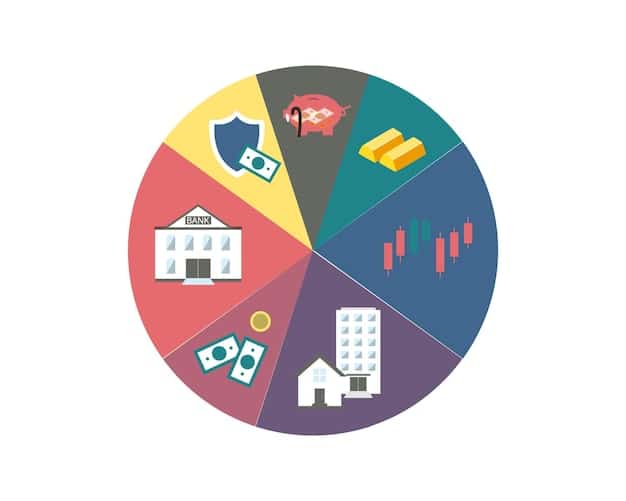Automate Your Finances: The Ultimate Guide for 2025

Finance Tips: The Ultimate Guide to Automating Your Savings and Investments in 2025 provides a comprehensive roadmap for individuals seeking to streamline their financial management through automation, covering budgeting, investing, and debt management strategies.
Are you looking to take control of your finances in 2025 and beyond? This guide, Finance Tips: The Ultimate Guide to Automating Your Savings and Investments in 2025, will show you how to automate your savings and investments, making financial management easier and more efficient. Let’s dive in!
Why Automate Your Finances?
Automating your finances might sound intimidating, but it’s a game-changer for anyone looking to save time and reduce stress. By setting up automatic transfers and investments, you can ensure your financial goals are always a priority, even when life gets busy.
Automation turns complex financial goals into manageable, bite-sized pieces handled consistently. It removes emotional decision-making, fostering a calm and rational approach to your money.
Benefits of Financial Automation
Financial automation offers several advantages. It’s not just about convenience; it’s about building a solid financial foundation.
- Saves Time: Automate routine tasks and free up your time for other priorities.
- Reduces Stress: Eliminate the need to manually track and manage every transaction.
- Ensures Consistency: Stay on track with your financial goals by automating contributions and payments.
- Minimizes Errors: Reduce the risk of human error in managing finances.
Automating your finances can also empower you to take calculated steps towards long-term financial security. By implementing smart systems, you can achieve a level of precision often unattainable through manual methods.
Getting Started: Assessing Your Financial Situation
Before diving into automation, it’s essential to get a clear picture of your current financial standing. Understanding your income, expenses, debts, and assets is the first step towards effective financial management.
Start by gathering all your financial documents and statements. This information will serve as the foundation for building your automated financial system.

Creating a Budget
A budget is a cornerstone of financial health. It allows you to see where your money is going and identify areas where you can save more.
- Track Your Income: List all sources of income, including salary, investments, and side hustles.
- Categorize Your Expenses: Divide your spending into categories such as housing, transportation, food, and entertainment.
- Identify Savings Opportunities: Look for areas where you can cut back on unnecessary spending.
- Set Financial Goals: Define specific, measurable, achievable, relevant, and time-bound (SMART) goals.
Budgeting is not about deprivation. By understanding where your money goes, you can make informed choices that align with your financial objectives, setting the stage for successful automation.
Automating Your Savings
Automating your savings is one of the most effective ways to build wealth without constantly thinking about it. By setting up automatic transfers to savings accounts, you can consistently grow your nest egg.
Starting with small, manageable amounts is key. Over time, these consistent savings will add up, creating a substantial financial cushion.
Setting Up Automatic Transfers
Automatic transfers are the backbone of automated savings. Arrange for a portion of your paycheck to be automatically deposited into your savings account.
Consider setting up multiple savings accounts for different goals. This helps you visually track your progress and stay motivated.
High-Yield Savings Accounts
Maximize your savings by choosing high-yield savings accounts. These accounts offer better interest rates than traditional savings accounts, helping your money grow faster.
- Research Options: Compare interest rates and fees from different banks and credit unions.
- Consider Online Banks: Online banks often offer higher interest rates due to lower overhead costs.
- Check FDIC Insurance: Ensure your savings account is FDIC-insured for added security.
Selecting a high-yield savings account provides an extra boost to your automated savings strategy, allowing you to achieve your financial goals faster and more efficiently.
Automating Your Investments
Investing can seem complex, but automating it simplifies the process and ensures you’re consistently building your investment portfolio. Regular, automated investments can help you take advantage of compound interest and long-term growth.
Don’t let fear of the unknown prevent you from automating your investments. Start small, learn as you go, and adjust your strategy as needed.

Using Robo-Advisors
Robo-advisors are a popular option for automating investments. These platforms use algorithms to create and manage your investment portfolio based on your risk tolerance and financial goals.
- Set Your Goals: Define your investment objectives, such as retirement, education, or a down payment on a home.
- Determine Your Risk Tolerance: Assess your comfort level with market fluctuations.
- Choose a Robo-Advisor: Research and select a robo-advisor that aligns with your needs and preferences.
Robo-advisors offer a hands-off approach to investing. By automating the process, you can consistently invest in the market without needing to constantly monitor and adjust your portfolio.
Setting Up Automatic Contributions
Once you’ve chosen your investment platform, set up automatic contributions. Schedule regular transfers from your bank account to your investment account.
Consider dollar-cost averaging, where you invest a fixed amount of money at regular intervals, regardless of market conditions. This strategy can help reduce the impact of market volatility on your investments.
Automating Bill Payments and Debt Management
Automating bill payments and debt management not only saves you time but also helps you avoid late fees and maintain a good credit score.
Late payments can negatively impact your credit score, which can affect everything from loan approvals to insurance rates. Automating bill payments can help you avoid these costly mistakes.
Setting Up Automatic Bill Payments
Most banks and service providers offer automatic bill payment options. Take advantage of these features to ensure your bills are paid on time, every time.
Review your accounts regularly to ensure sufficient funds are available and that your payments are being processed correctly.
Automating Debt Repayments
If you have debts, such as student loans or credit card balances, automate your repayments. Set up automatic transfers to pay off your debts faster and save on interest charges.
- Consolidate Debts: Consider consolidating high-interest debts into a single loan with a lower interest rate.
- Set Up Autopay: Enroll in autopay programs offered by your lenders to ensure timely payments.
- Track Your Progress: Monitor your debt balances regularly to stay motivated and on track.
Automated debt repayments can help accelerate your journey toward financial freedom. By consistently paying down your debts, you can free up more money for savings and investments.
Reviewing and Adjusting Your Automated Systems
While automation can streamline your finances, it’s essential to regularly review and adjust your systems. Financial goals and circumstances change, so your automated strategies should evolve accordingly.
Periodic reviews prevent stagnation. By staying engaged and making necessary adjustments, you can ensure your automated systems remain effective and aligned with your financial aspirations.
Regular Financial Check-Ups
Schedule regular financial check-ups to review your income, expenses, savings, and investments. This will help you identify any areas that need improvement and make necessary adjustments to your automated systems.
Use this time to reassess your financial goals and ensure they still align with your long-term plans.
Adjusting Your Strategies
As your income, expenses, and financial goals change, adjust your automated savings, investments, and debt repayment strategies accordingly. This ensures your systems remain effective and aligned with your current situation.
- Increase Savings: As your income increases, consider increasing your automatic savings contributions.
- Rebalance Your Portfolio: Periodically rebalance your investment portfolio to maintain your desired asset allocation.
- Adjust Debt Repayments: As you pay off debts, redirect those funds toward savings and investments.
Adjusting your financial strategies keeps you proactive and responsive to life’s changes. This dynamic approach ensures you stay on track to achieve your financial dreams, no matter what.
| Key Point | Brief Description |
|---|---|
| 💰 Automate Savings | Set up automatic transfers to savings accounts. |
| 📈 Automate Investments | Use robo-advisors and automatic contributions. |
| 🧾 Automate Bill Payments | Schedule automatic bill payments with banks. |
| 🏦 High-Yield Accounts | Choose high-yield savings accounts for better returns. |
Frequently Asked Questions
Financial automation involves setting up systems to manage your finances automatically. This includes tasks like saving, investing, and paying bills without manual intervention.
You can automate your savings by setting up automatic transfers from your checking account to your savings account. Many banks allow you to schedule these transfers regularly.
Robo-advisors are online platforms that use algorithms to manage your investments automatically. They’re a convenient way to automate your investing based on your risk tolerance.
Most banks and service providers offer automatic bill payment options. You can set up these payments through your bank’s website or the service provider’s platform.
You should review your automated systems at least once a quarter. This will help you ensure they are still aligned with your financial goals and make any necessary adjustments.
Conclusion
Automating your savings and investments is a powerful strategy for achieving financial success in 2025 and beyond. By implementing these tips, you can simplify your financial life, save time, and build a secure financial future.





